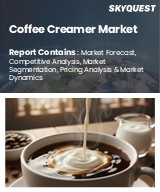
|
시장보고서
상품코드
1697880
인도의 커피 시장 : 유형별, 형태별, 유통 채널별, 최종 용도별, 지역별, 기회, 예측(2019-2033년)India Coffee Market Assessment, By Type, By Form, By Distribution Channel, By End-use, By Region, Opportunities and Forecast, FY2019-FY2033F |
||||||
인도의 커피 시장 규모는 2026-2033년의 예측 기간 동안 7.56%의 연평균 복합 성장률(CAGR)로 확대되어 2025년 10억 5,000만 달러에서 2033년 18억 8,000만 달러로 성장할 것으로 예상됩니다. 인도의 커피 시장의 성장에는 주로 가처분 소득 증가, 서유럽식 라이프스타일에 대한 선호, 스페셜티 커피의 인기 상승, 커피숍 문화의 확대 등 몇 가지 중요한 요인이 있습니다.
커피 산업을 재편하는 가장 주목할 만한 트렌드 중 하나는 커피 소비의 프리미엄화입니다. 스타벅스 인도는 타타타(Tata)와의 제휴를 통해 인도 소비자들에게 스페셜티 커피를 소개하고, 블루토카이, 써드웨이브 커피와 같은 브랜드가 주도하고 있습니다. 인도 내 약 400개의 매장을 운영하고 있습니다.
인도는 세계 최고의 커피 생산국이며, 어떤 커피가 우세한가 하면 로부스타 품종이 주도하고 있습니다. 인도의 커피 생산량의 약 70%는 로부스타 품종이며, 나머지 30%는 아라비카 품종입니다. 로부스타 품종은 수확량이 많고, 해충에 강하며, 다양한 기후에서 자라기 때문에 인도의 많은 농부들이 선호하며, 안정적이고 수익성이 높은 작물입니다.
인도에서는 매년 약 36만 톤의 커피가 생산되고 있으며, 그 중 25만 톤이 로부스타종, 11만 톤이 아라비카종입니다. 로부스타 품종은 풍미가 강하고 카페인 함량이 높아 인스턴트 커피나 블렌딩 제품에 적합하며, 인도뿐만 아니라 전 세계적으로 높은 인기를 누리고 있습니다. 이러한 수요의 좋은 예는 인도산 로부스타의 이탈리아, 독일, 러시아로의 수출이 증가하고 있으며, 에스프레소 블렌딩에 널리 사용되고 있다는 점입니다. 생산량, 수출량 모두 로부스타 품종이 압도적으로 많으며, 인도는 세계 커피 시장에서의 입지를 지속적으로 강화하고 있습니다. 고품질 커피에 대한 수요가 증가함에 따라 인도의 커피 산업은 더욱 발전할 것으로 보입니다. 이 커피의 대부분은 3개 주요 주(카르나타카, 케랄라, 타밀 나두)에서 생산됩니다. 이 세 주를 합치면 인도의 커피 생산량의 90% 이상을 차지합니다. 인도커피협회에 따르면, 카르나타카주는 인도 커피의 중심지로 연간 23만 톤을 생산하고 있으며, 케랄라주가 7만 톤 이상을 생산하고 있습니다. 타밀나두주는 생산량은 적지만 고급 아라비카 커피의 산지로 알려져 있으며, 매년 약 18,000-20,000톤을 생산하고 있습니다.
인도의 커피 시장에 대해 조사했으며, 시장 개요와 함께 유형별/형태별/유통 채널별/최종 용도별/지역별 동향, 시장 진출 기업 프로파일 등의 정보를 전해드립니다.
목차
제1장 프로젝트의 범위와 정의
제2장 조사 방법
제3장 주요 요약
제4장 고객 소리
제5장 인도의 커피 시장 전망, 2019년-2033년
- 시장 규모 분석과 예측
- 시장 점유율 분석과 예측
- 2025년 시장 맵 분석
- 유형별
- 형태별
- 유통 채널별
- 최종 용도별
- 지역별
제6장 수급 분석
제7장 수출입 분석
제8장 밸류체인 분석
제9장 Porter의 Five Forces 분석
제10장 PESTLE 분석
제11장 가격 분석
제12장 시장 역학
- 시장 성장 촉진요인
- 시장이 해결해야 할 과제
제13장 시장 동향과 발전
제14장 정책과 규제 상황
제15장 사례 연구
제16장 경쟁 구도
- 시장 리더 TOP 5의 경쟁 매트릭스
- 참여 기업 TOP 5의 SWOT 분석
- 시장 주요 시장 진출기업 TOP 11의 상황
- Tata Coffee Limited
- Hindustan Unilever Limited
- Nestle India Ltd.(Nescafe)
- Coffee Day Enterprises Ltd(Cafe Coffee Day)
- Tata Starbucks Private Ltd.,
- S.L.N. Coffee Pvt. Ltd.(Levista)
- Muhavra Enterprises Private Limited(Blue Tokai)
- Koinonia Coffee Pvt. Ltd
- CCL Products(India) Limited
- ITC Ltd.(Sunbean)
- Seven Beans Coffee Company Pvt Ltd.
제17장 전략적 제안
제18장 리서치사에 대해 & 면책사항
LSH 25.04.16India coffee market is projected to witness a CAGR of 7.56% during the forecast period FY2026-FY2033, growing from USD 1.05 billion in FY2025 to USD 1.88 billion in FY2033. Several key factors drive the growth of India coffee market, primarily rising disposable incomes, a preference for western lifestyles, the increasing popularity of specialty coffee and the expansion of coffee shop culture.
One of the most notable trends in reshaping the industry is the premiumization of coffee consumption. The emergence of third-wave coffee culture has introduced Indian consumers to specialty coffee experiences, with brands like Blue Tokai and Third Wave Coffee leading the charge. Starbucks India, through its partnership with Tata, has successfully positioned itself in this premium segment, operating about 400 stores across the country.
Robusta versus. Arabica: Which Coffee Rules the Indian Market?
India is one of the world's top coffee producers, and when it comes to which type dominates, Robusta takes the lead. Around 70% of India's coffee production is Robusta, while Arabica makes up the remaining 30%. Robusta is the preferred choice for many Indian farmers because it yields more, resists pests better, and thrives in a wider range of climates, making it a reliable and profitable crop.
India produces about 360,000 metric tons of coffee every year, with 250,000 metric tons being Robusta and 110,000 metric tons Arabica. Robusta's stronger flavor and higher caffeine content make it the top choice for instant coffee and blended products, which are highly popular in India and worldwide. A great example of this demand is seen in the growing exports of Indian Robusta to Italy, Germany, and Russia, where it's widely used in espresso blends. With Robusta dominating both production and exports, India continues to strengthen its position in the global coffee market. As demand for high-quality coffee grows, India's coffee industry is set to thrive even further. Most of this coffee comes from three major states: Karnataka, Kerala, and Tamil Nadu, which together account for more than 90% of India's total coffee production. According to Coffee Board, India, Karnataka is the coffee capital of India, producing 230,000 metric tons annually followed by Kerala contributing over 70,000 metric tons, with Robusta being the dominant variety due to its tropical climate, which supports its growth. Tamil Nadu, though smaller in production, is known for its premium Arabica coffee, producing around 18,000-20,000 metric tons each year.
Global Demand for Indian Coffee Helps Fuel Market Growth
India's coffee industry shows an interesting development. While India has mainly been known for exporting coffee, the growing international demand for Indian coffee beans is now also helping to improve the local market. This connection between global trade and domestic growth is creating positive changes across the industry. As Indian coffee gains more recognition worldwide, it's also raising standards at home. Local specialty coffee companies like Blue Tokai and Third Wave Coffee are now offering high-quality Indian coffee varieties, using the same strict quality measures developed for exports.
India is currently the seventh-largest coffee producer in the world, contributing significantly to the global coffee. Among its top importers are Italy, Germany, Russia, Belgium, and Turkey. For the last three years, multiple factors like fluctuating international coffee prices, supply chain inefficiencies, and unpredictable climate conditions affected the export market, however the latest data predicts a fortunate outcome for the coffee industry with reports from quarter of 2025 (January-March) showing total export of 98,377 metric tons with the value of USD 519 million.
Domestic Coffee Consumption on the Rise
While India has long been a tea-drinking nation, domestic coffee consumption has been growing steadily with 7-10% annual increase in coffee consumption, fueled by urbanization, rising disposable incomes, and the expansion of global coffee chains.
The popularity of premium and specialty coffee is increasing, particularly among younger consumers who seek high-quality brews. Home brewing methods like South Indian filter coffee and artisanal drip coffee have also contributed to shifting consumer preferences. However, despite this surge, per capita coffee consumption in India remains low compared to global standards, presenting a significant opportunity for further market penetration. To capitalize on this trend, domestic brands and cafe chains must focus on product diversification, experiential marketing, and expanding their presence in Tier 2 and Tier 3 cities. For instance, coffee consumption in India increased from 91,000 metric tons in Coffee Year 2023 (1st October to 30th September of following year) and is estimated at 90,000-95,000 metric ton in Coffee year 2024.
Government Measures to Support Market Growth
Government policies play a crucial role in shaping the Indian coffee industry. The Coffee Board of India has been instrumental in promoting coffee cultivation, research, and export growth. Recent initiatives include subsidies for farmers, financial support for infrastructure development, and marketing incentives for global branding.
A prime example of this success is Araku Valley, where nearly 150,000 tribal families in collaboration with the Coffee Board and the Integrated Tribal Development Agency (ITDA) have increased coffee production by 20%.
However, industry experts believe that more policy-level interventions are needed, including lower taxation on coffee exports, investment in technology for processing, and the promotion of Indian coffee at international trade fairs. Strengthening collaborations between the government, private sector, and farmer cooperatives will be key to ensuring the long-term sustainability of the coffee industry.
Future Market Scenario (FY2026 - FY2033F)
Coffee market will continue to grow due to strong demand from foreign consumers and steady increase in number of Coffee drinkers in India.
The market will grow strongly based on continued expansion from exports and subsidies for supporting individual farmers.
The demand for Coffee will continue to expand further with the growth of cafe chains and institutional sales.
Key Players Landscape and Outlook
India's coffee market is undergoing a quiet transformation. Long dominated by tea, the country is now embracing coffee culture at a steady pace which is driven by urbanization, rising disposable incomes, and the influence of global trends.
International players are also making their mark. Starbucks, through its partnership with Tata, has established a strong foothold with nearly 400 stores, while Tim Hortons has entered the market with an aggressive expansion strategy. These global brands are not just competing with each other but also with homegrown chains such as Barista and Cafe Coffee Day, which are adapting to stay relevant.
Table of Contents
1. Project Scope and Definitions
2. Research Methodology
3. Executive Summary
4. Voice of Customers
- 4.1. Respondent Demographics
- 4.2. Brand Awareness
- 4.3. Factors Considered in Purchase Decisions
- 4.4. Challenges Faced Post Purchase
5. India Coffee Market Outlook, FY2019-FY2033F
- 5.1. Market Size Analysis & Forecast
- 5.1.1. By Value
- 5.1.2. By Volume
- 5.2. Market Share Analysis & Forecast
- 5.2.1. By Type
- 5.2.1.1. Arabica
- 5.2.1.2. Robusta
- 5.2.1.3. Others
- 5.2.2. By Form
- 5.2.2.1. Instant Coffee
- 5.2.2.2. Ground Coffee
- 5.2.2.3. Whole Grain
- 5.2.2.4. Others
- 5.2.3. By Distribution Channel
- 5.2.3.1. Supermarkets/Hypermarkets
- 5.2.3.2. Grocery Stores
- 5.2.3.3. Specialty Stores
- 5.2.3.4. Online
- 5.2.3.5. Others
- 5.2.4. By End-use
- 5.2.4.1. Residential
- 5.2.4.2. Commercial
- 5.2.4.3. Institutional
- 5.2.5. By Region
- 5.2.5.1. North
- 5.2.5.2. South
- 5.2.5.3. East
- 5.2.5.4. West and Central
- 5.2.6. By Company Market Share Analysis (Top 5 Companies and Others - By Value, FY2025)
- 5.2.1. By Type
- 5.3. Market Map Analysis, FY2025
- 5.3.1. By Type
- 5.3.2. By Form
- 5.3.3. By Distribution Channel
- 5.3.4. By End-use
- 5.3.5. By Region
6. Demand Supply Analysis
7. Import and Export Analysis
8. Value Chain Analysis
9. Porter's Five Forces Analysis
10. PESTLE Analysis
11. Pricing Analysis
12. Market Dynamics
- 12.1. Market Drivers
- 12.2. Market Challenges
13. Market Trends and Developments
14. Policy and Regulatory Landscape
15. Case Studies
16. Competitive Landscape
- 16.1. Competition Matrix of Top 5 Market Leaders
- 16.2. SWOT Analysis for Top 5 Players
- 16.3. Key Players Landscape for Top 11 Market Players
- 16.3.1. Tata Coffee Limited
- 16.3.1.1. Company Details
- 16.3.1.2. Key Management Personnel
- 16.3.1.3. Key Products Offered
- 16.3.1.4. Key Financials (As Reported)
- 16.3.1.5. Key Market Focus and Geographical Presence
- 16.3.1.6. Recent Developments/Collaborations/Partnerships/Mergers and Acquisition
- 16.3.2. Hindustan Unilever Limited
- 16.3.3. Nestle India Ltd. (Nescafe)
- 16.3.4. Coffee Day Enterprises Ltd (Cafe Coffee Day)
- 16.3.5. Tata Starbucks Private Ltd.,
- 16.3.6. S.L.N. Coffee Pvt. Ltd. (Levista)
- 16.3.7. Muhavra Enterprises Private Limited (Blue Tokai)
- 16.3.8. Koinonia Coffee Pvt. Ltd
- 16.3.9. CCL Products (India) Limited
- 16.3.10. ITC Ltd. (Sunbean)
- 16.3.11. Seven Beans Coffee Company Pvt Ltd.
- 16.3.1. Tata Coffee Limited
Companies mentioned above DO NOT hold any order as per market share and can be changed as per information available during research work.



















